Mechanized screed: screeding with construction machines
To level the surface of the floor and prepare it for laying the finish coat, screeds made using various technologies are used. Traditional is a wet screed made from a liquid cement-sand mortar. It dries for a long time, thanks to a large amount of water, during shrinkage changes its geometry and sometimes goes cracked. The complexity of the wet screed is quite high, since most of the operations for its manufacture (except for mixing the solution) are performed manually. This is not always convenient. Especially when it is supposed to level large areas of the floor. Therefore, in order to facilitate and accelerate the laying of cement-sand mixture, a new technology was introduced into construction practice - mechanized or machine screed. During its manufacture and installation, part of the operational processes is done by machines, which affects a significant reduction in the duration and complexity of the work.
It is worth noting immediately that the raw material for the mechanized screed is not a wet solution (as in the classical case), but a semi-dry cement-sand mixture. Water is added to this mixture to a minimum, only for cement hydration. In other words, a mechanized screed is a semi-dry screed not made manually, but with the help of machines.
Components for the production of semi-dry screed are almost identical to the classic version. Kneading is performed from:
- sand of medium size, fractions up to 5mm;
- cement M400-500;
- fiberglass;
- plasticizers;
- water.
The average thickness of a mechanized screed is 5-8 cm. This is enough to hide various communications in its thickness: heating or water pipes, electrical wiring, floor heating systems.
Content
The use of mechanisms for machine screed
Work in a mechanized way implies high automation and the use of special construction equipment - for the manufacture (mixing of components) of the mixture, feeding it to the place of laying, grouting and polishing the surface.
A solution for mechanized screed is made immediately before the start of work at the construction site. For kneading, a pneumatic blower is used, combining the functions of a mixer and a concrete pump. The components are loaded into the tank of the air heater, mixed and fed, under the influence of compressed air, to the place of installation. The feed is carried out by dense rubber hoses (diameter 50-65 mm). The power of the pump allows you to transport the mixture horizontally to a distance of 180 m, and vertically - up to 100 m (to a height of 30 floors).
A pneumatic blower is installed on the street near the house (under the windows or at the entrance to the entrance), sand, cement, fiber and other additives (if necessary), water are stored nearby. The components are mixed outdoors, while there is no need to bring them into the house or raise them to the desired floor - the finished mixture is fed to the place of work by hoses. Thus, the room in which the screed is laid will remain relatively clean - without building dust and lumps of mortar along the walls.
After laying and the initial alignment of the solution as a rule, the turn comes to use another mechanism - a disk grinder.Its working element is a grinding disc, with the help of which grouting, elimination of empty and sinks, screed sealing. Since the humidity of the cement-sand mixture is initially minimal, leveling the screed with grinders is carried out almost immediately after installation (after a couple of hours), without stopping the process.
As a result of the work of grinding machines, the surface becomes perfectly flat - without tubercles and shells. Due to this, the mechanized floor screed does not need additional leveling with bulk mixtures or sheet materials. The resulting floor base is suitable for direct laying on it of any finishing coating, even sensitive to the slightest bumps (for example, a laminate or piece parquet).
Advantages and disadvantages of mechanized semi-dry screed
Taking into account the features of the described technology, we denote all the advantages of a semi-dry mechanized screed.
1. Fast hardening
For mixing a semi-dry screed, a minimum amount of water is used, which quickly evaporates after laying. Due to this, the worker in special shoes (wide and long pads, similar to skiing) can move on the surface 1-2 hours after installation - to grout the screed. This significantly saves time on the entire process.
Walking in the usual step and in ordinary shoes with a semi-dry screed is allowed after a day. And after 4-5 days, lay linoleum or tile on it. Installation of materials more unstable to possible moisture - laminate and parquet - is allowed to be carried out after 8-10 days.
2. The absence of shrinkage cracks
A small amount of water in the mixture has a positive effect on the quality of the hardening screed. The fact is that during the evaporation of water, the cement-sand mixture undergoes shrinkage, which leads to the appearance of shrinkage cracks. There is little water in the semi-dry mixture; accordingly, the risk of such cracks is at a minimum level.
An obligatory component of the mechanized screed - polypropylene fiber also works against cracking. These are small polypropylene fibers added to the mixture. They are evenly distributed in the screed and bind its particles into a single whole. Therefore, the fibrous screed does not crack.
3. High speed execution
Thanks to the use of high-performance machines and the absence of technological downtime, the speed of a mechanized coupler compares favorably with the classic manual alternative. A team of workers (4-6 people) for a shift can lay 150-250 m2 semi-dry screeds. That is, a mechanized screed in the apartment is done in 1 day!
Hand screed using wet technology - in 5-7 days (mixing and transportation of the mortar, laying the screed, removing beacons in a few days, finishing grouting is required).
4. An even base that does not require finishing leveling for flooring
Even in the wet state, the mechanized screed is sanded with disk trowels. The result is a smooth and even surface suitable for laying any finishing material: linoleum, parquet, laminate, tile, cork, etc. The permissible unevenness of the mechanized screed is 2 mm by 3 m.
5. High automation of work, reduced labor intensity
The preparation of the solution, its transportation to the place of laying and grinding are carried out using modern building mechanisms. Mixing the components of the solution is carried out in a pneumosupercharger; flexible hoses go from it, along which the mixture moves to the place of work. Screed leveling is done by trowel disc machines. Automation of work leads to acceleration of the process, simplification of work and improve the quality of the resulting screed.
6. Lack of pollution from preparation of solution indoors
Preparation of the mixture for a semi-dry screed is carried out on the street, respectively, in the room there will be no dust from cement and additives, spray from the solution on the walls.
7. Lack of leaks in the floors
Since the working mixture for a semi-dry screed contains very little water, there is no risk of fluid seeping to the lower floor when laying it.
The disadvantages of the machine coupler include:
1. The use of expensive mechanisms
Mechanized screed can not be performed independently, since the technology of work provides for the availability of specialized equipment. Buying it or renting it for one-time work is too expensive a pleasure. Moreover, with a dubious result, since you need to be able to handle this technique. It is only capable of professional workers with experience.
2. Many professional organizations accept only large areas
Most specialized companies, in relation to the mechanized screed, have the concept of “minimum order”, which can be 100-500 m2. Therefore, if the area of your apartment is smaller than the organization you have chosen, you will have to look for partners to order. In other words, cooperate with neighbors and make a general order for laying screeds in several apartments.
3. High price
When performing a mechanized screed, expensive construction equipment is used, which requires operating and repair costs. Accordingly, the cost of such a coupler is slightly higher than its manual counterpart.
Mechanized screed technology
Machine screed is carried out only by specialized construction companies with the necessary mechanisms.
Technological stages of laying mechanized screed:
1. Foundation preparation
The floor is cleaned of debris, dust, remove all unnecessary. All detected cracks and potholes are filled with cement-sand mortar or putty. The surface is treated with a primer.
For waterproofing, noise insulation and preventing quick and uneven drying of the screed, a plastic film (100 μm thick) or a foam polyethylene substrate (5-10 mm thick) is laid on the surface. A damper tape made of foamed polyethylene is mounted along the perimeter of the room along the walls so that it is 3-5 cm higher than the calculated level of the screed. After the screed has hardened, the part of the tape protruding above its level is cut off.
2. Level mark screed
Using a laser level, a zero level is set around the entire perimeter of the room - a horizontal line passing through the highest point of the floor. From it, the calculated thickness of the screed is measured upwards and a new horizontal is obtained - the level of the screed.
3. Preparation of the working mixture
The working mixture is kneaded at the construction site in the hopper of the pneumosupercharger. Work is carried out at a temperature not lower than -5 ° C. If it is colder on the street, a “teplyak” is built above the place of storage of materials and the preparation of the solution.
The materials are loaded into the chamber of the pneumatic blower, with constant stirring, in the following sequence: 1 - sand, 2 - fiber, 3 - cement, 4 - water with plasticizer dissolved in it. Stirring is performed for three minutes.
4. Transportation and acceptance of the finished mixture
The supply of the working mixture to the place of laying the screed is also carried out by a pneumatic blower. This mechanism with the help of compressed air transports the mixture along the hoses (hoses) of high pressure to the desired floor or horizontal distance.
Acceptance of the mixture takes place in a special absorber connected to the transport hose.
5. Manual distribution of the mixture using the rule
Work on the installation of a semi-dry screed is carried out indoors at a temperature of at least + 5 ° C.
Using the laser level, beacons are first formed from the working mixture.Two lighthouses - along opposite walls, if the room is wide, then a few more intermediate lighthouses (the distance between them, in any case, should be less than the length of the existing rule by about 20 cm).
The space between the laid beacons is filled with a working mixture and leveled with its rule (length 1.5-3 m), creating an even screed plane.
6. Grout screed disc grinder
A couple of hours after leveling, the screed is rubbed and ground, passing through it with a grinding disc. Additionally, moisten the surface is not required. Sanding smoothes the surface, eliminates minor irregularities: pits and tubercles.
7. Cutting expansion joints
After grouting for 3 hours, the compensation (deformation) joints are cut using a special fugel. Seams should have a depth of 10-20 mm, a thickness of 5-7 mm. Marking of expansion joints is carried out according to the design documentation. If it is absent, then the seams are placed in the doorways, in the places of adjacency to the columns and niches, in areas with elevation differences. In large rooms, expansion joints are placed so as to divide the floor plane into squares or rectangles - 15-20 m each2.
8. Care for hardening screed
If there are drafts in the room, intense sunlight and dry air, it is recommended to cover it with plastic wrap for 1-2 days until the screed is completely dry. In rooms where the temperature exceeds 22 ° C or intense air exchange is present, it is advisable to moisten its surface a little before covering the screed.
After removing the film, you can enjoy a solid and even surface. And after a few days, when the screed dries up, lay the flooring. Although experts know that the final set of strength of a semi-dry screed occurs much later - after 28 days. Therefore, if the deadlines are tolerated, it is recommended to wait with the installation of the finishing base and proceed with it after the final maturation of the screed.
In conclusion, we suggest that you familiarize yourself with the video, in the plot of which it is shown how a team of a specialized construction company performs a mechanized screed.

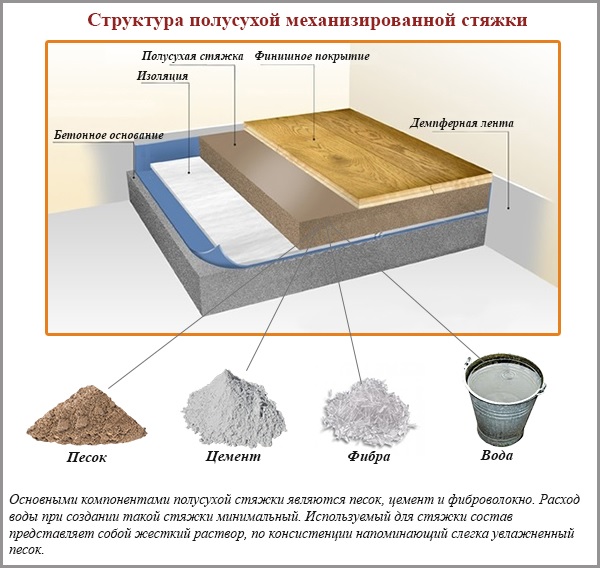
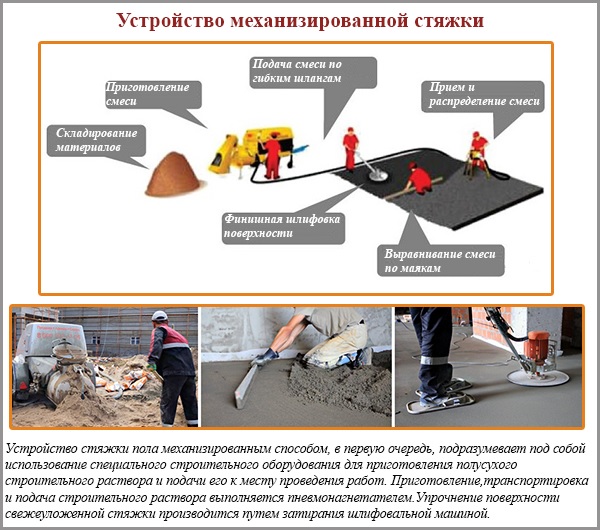

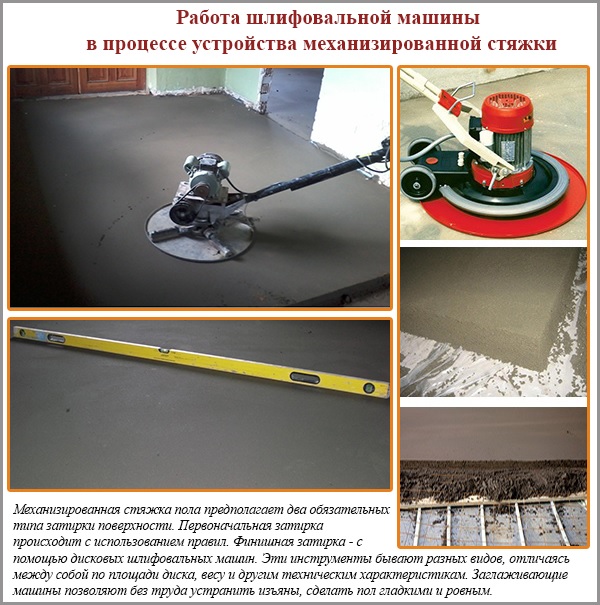
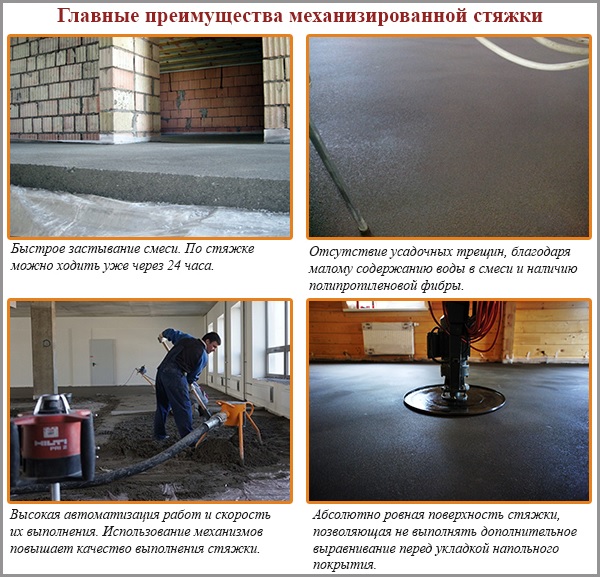
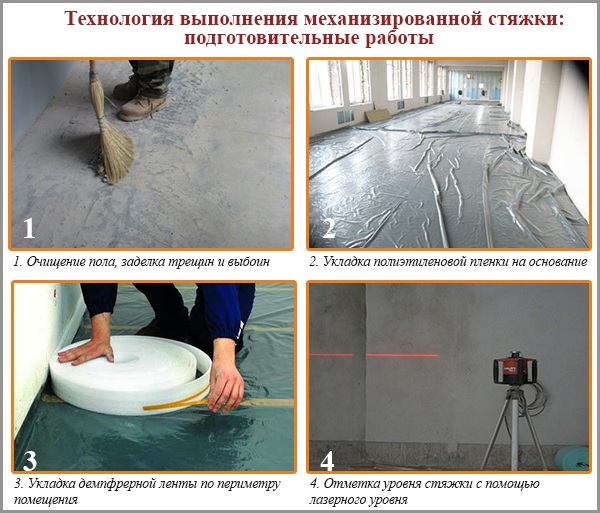
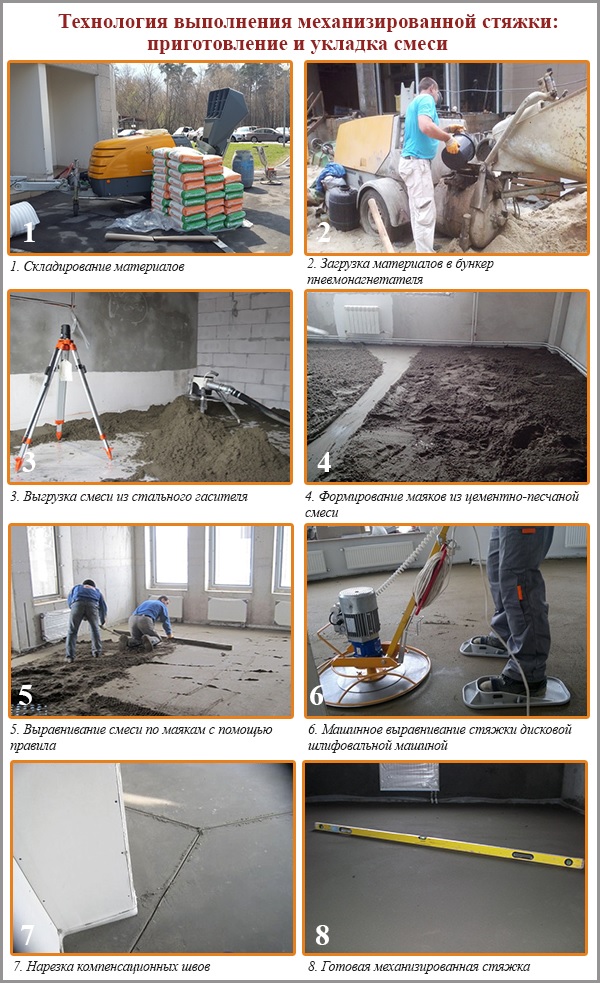
2 comments